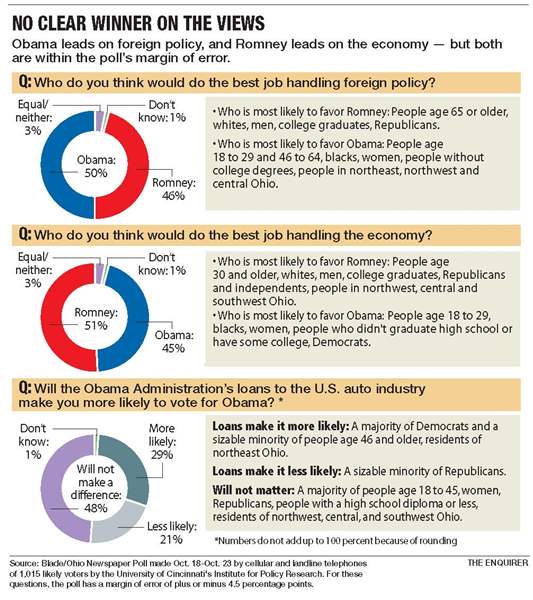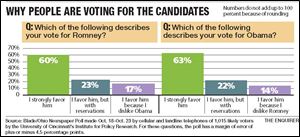
Romney tied with Obama in Ohio poll
Independent voters think GOP candidate can change economy
10/28/2012

Boosted by a surge among male voters who think he’s the best candidate to fix the economy, Republican Mitt Romney has come back to tie President Obama in battleground Ohio.
They are deadlocked at 49 percent in a new Blade/Ohio News Organization poll. President Obama was ahead by 5 points in the same poll published Sept. 16. How does that tie get broken in the next nine days?
“In the final days before the election, both campaigns will focus on turning out their bases, appealing to independents, and attracting the few undecided voters that remain,” said Eric Rademacher, co-director of the University of Cincinnati’s Institute for Policy Research, which conducted the poll for Ohio’s eight largest newspapers.
The Buckeye State, the nation’s top presidential bellwether since 1900, is always important in a presidential election. But this year may be giving Ohio voters an attention-surplus disorder, with more than 70 visits by presidential candidates or their running mates, unprecedented ad spending, and reporters from around the world fanning the state. Last week, a New York Times statistical analysis called Ohio more important than the other 49 states combined.
In the new poll, President Obama wins support for his foreign policy and for pushing the auto loan package for GM and Chrysler. He also benefits somewhat from damage to Mr. Romney from his secretly recorded remarks about the “47 percent” of Americans he said are dependent on the government.
But the former Massachusetts governor scores with his performance in the debates. And on the crucial question of who would do the best job handling the economy, Mr. Romney prevails by 6 percentage points among all voters — and 18 percent among independents.
“If this poll reflects final voting patterns among Democrats and Republicans, Ohio’s independent voters may hold the keys to both Ohio and the presidency,” Mr. Rademacher said.
“The poll suggests independent preferences may move around depending on whether they are asked about the economy as a whole, the President’s handling of the auto industry, or the 47 percent issue."
Male voters have swung sharply toward Mr. Romney in the past month. In September, he was winning by 2 points among men on who could best improve economic conditions in Ohio. Now, he’s up by 19 on a slightly different question, who can better handle the economy. Overall, his lead with men has jumped from 1 to 12 points.
Mr. Romney wants more voters like poll participant Wesley Allen, 41, a welder at southern Ohio’s Ripley Metal Works, where he said employees have worked with a 25 percent pay cut for almost two years. Mr. Allen said he voted for Mr. Obama in 2008.
“Four years ago, I made a mistake. I fell for the whole ‘change’ thing,” he said. “I got on the ‘change’ train. But there wasn’t any change.”
This year, Mr. Allen already has made plans with four co-workers to meet in front of his Ripley home at 6 a.m. on Election Day and go vote together — all for Mr. Romney.

Toledoan Barbara Helm, 50, a homemaker, said she has family members who work for the auto manufacturers and it’s obvious to her that Mr. Obama saved their jobs with his 2009 auto industry rescue.
“I was very impressed. Actually I think he did very good his first four years considering all he had on the table when he got in office because we were in a big mess from [George] Bush, and I don’t know why he got back in,” Mrs. Helm said.
She’s suspicious of the Romney campaign and fears a replay in Ohio of the voting mixups that cast credibility on the 2000 election in Florida.
Mr. Obama wants more voters like respondent Bruce Meyer, 46, a sales director from Akron who said he is backing the President despite the country’s economic struggles.
“I think we’re on the right course, and to change course now would be a big mistake.”
He said Mr. Romney’s remarks about the “47 percent” solidified his thinking.
“I don’t think he has any understanding whatsoever of raising a family and getting up and getting to work on a day-to-day and month-to-month basis. I just don’t think he gets people like me.”
After months of negativity in campaign ads, mailers, automated phone calls, and stump speeches, perhaps it’s not surprising that 61 percent of Ohio voters say they are “scared” about who may prevail in this year’s presidential election.
But it’s an equal-opportunity fright: 29 percent say they would be scared if Mr. Romney wins, and the exact same percentage expresses fear if Mr. Obama gets a second term.

And then there’s the 3 percent who say they are scared no matter who wins.
Kevin Taylor, 39, of Monroe near Cincinnati, an attorney and account manager for a sales team, said he is voting for Mr. Romney as “the lesser of two evils.” But he worries how much of Mr. Romney’s experience “translates to a more global setting that the President would require.”
Mr. Taylor’s mirror image is Rosemary Crum, 68, a retired pharmacist from Pickerington, southeast of Columbus.
“Obama’s the lesser of two evils,” she said. “I’m not necessarily a supporter of Obama, but there’s something about Romney I just can’t stand. There’s nothing about him that says, ‘Trust me.’ His mouth says that, but nothing else.”
Nearly 1 in 5 Ohio voters said they already had cast an early ballot, and President Obama was ahead among this group by 27 points, 63 percent to 36 percent.
More Democrats than Republicans say they will “definitely vote.”
However, 58 percent of Republicans describe themselves as “very enthusiastic” about the election, compared to 48 percent of Democrats.
The telephone poll conducted by the Institute for Policy Research at the University of Cincinnati between Oct. 18 and Oct. 23 of 1,015 likely voters has a margin of sampling error of plus or minus 3.1 percentage points. The response rate was 19.5 percent.
Blade Politics Writer Tom Troy, Jane Prendergast of The Cincinnati Enquirer, and Randy Ludlow of The Dispatch contributed to this story.